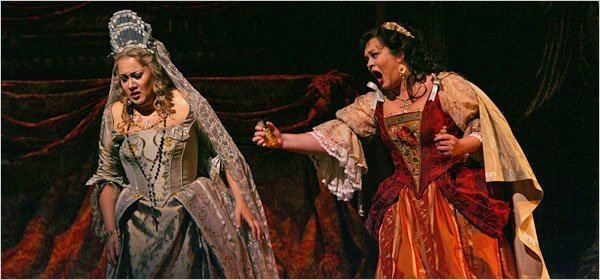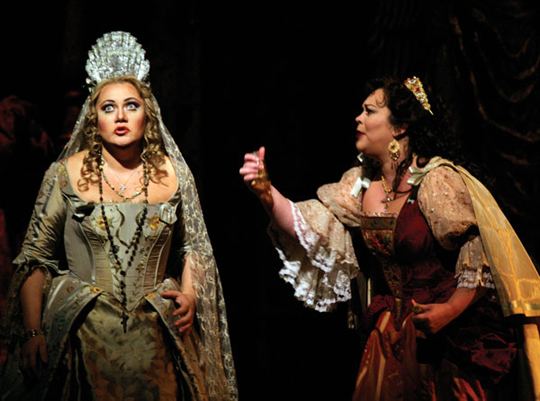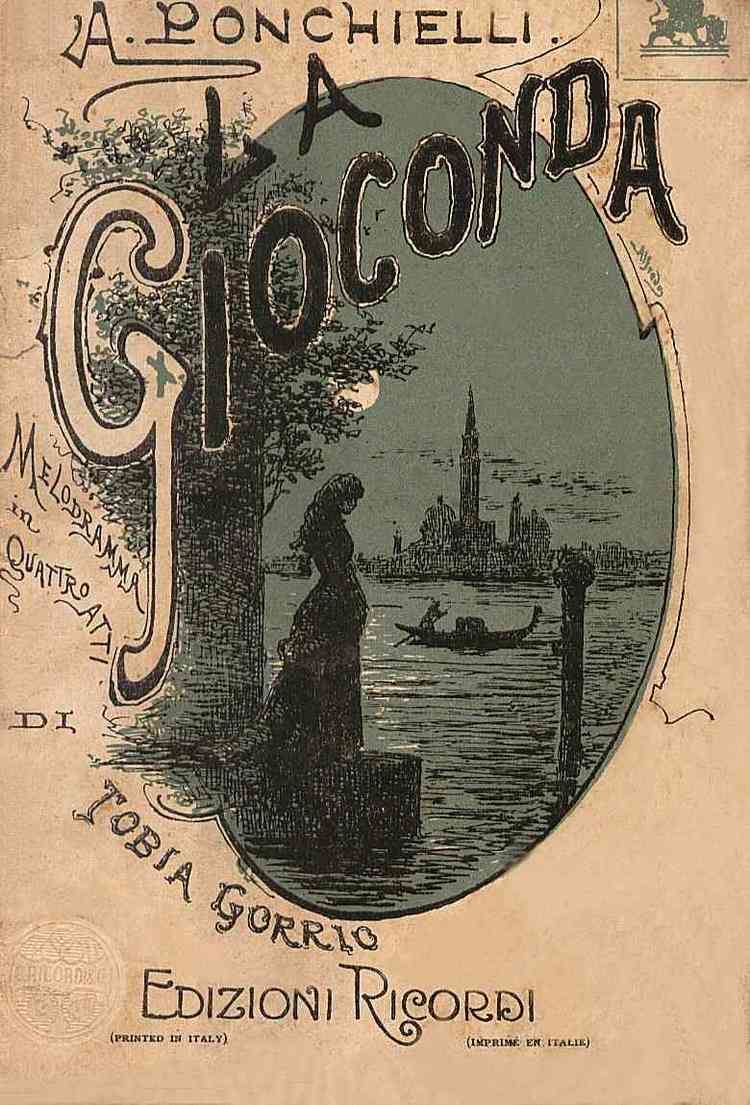First performance 8 April 1876 | ||
 | ||
Adaptations The Fighting Prince (1958) Arias O monumento, Voce di donna o d'angelo, Suicidio!, Cielo e mar, Si! Morir ella de! Characters Enzo Grimaldo, Isèpo, Laura Adorno, Alvise Badoero, La Cieca, A singer, Barnaba, A pilot, Zuàne, Gioconda Similar Mefistofele, Andrea Chénier, Otello, La forza del destino, Cavalleria rusticana | ||
La Gioconda is an opera in four acts by Amilcare Ponchielli set to an Italian libretto by Arrigo Boito (as Tobia Gorrio), based on Angelo, Tyrant of Padua, a play in prose by Victor Hugo, dating from 1835. (This is the same source as Gaetano Rossi had used for his libretto for Mercadante's Il giuramento in 1837).
Contents
- Performance history
- Synopsis
- Act 1 The Lions Mouth
- Act 2 The Rosary
- Act 3 The Ca dOro House of Gold
- Act 4 The Orfano Canal
- Parodies of the ballet music
- Audio
- Film or video
- Adaptations in other media
- References

First performed in 1876, La Gioconda was a major success for Ponchielli, as well as the most successful new Italian opera between Verdi's Aida (1871) and Otello (1887). It is also a famous example of the Italian genre of Grande opera, the equivalent of French Grand-Opéra.

Ponchielli revised the work several times; the version that is played today was first given in 1880. There are several complete recordings of the opera, and it is regularly performed, especially in Italy. It is one of only a few operas that features a principal role for each of the six major voice types.

Performance history

La Gioconda was first performed at the Teatro alla Scala, Milan, on 8 April 1876. It was especially successful in its third and final version first seen at the same theatre on 28 March 1880. The opera had its American premiere at the Metropolitan Opera on 20 December 1883.
Synopsis

The opera's title translates as The Happy Woman, but is usually given in English as The Ballad Singer. However, as this fails to convey the irony inherent in the original, the Italian is usually used. Each act of La Gioconda has a title.
Place: VeniceTime: 17th centuryThe story revolves around a woman, Gioconda, who so loves her mother that when Laura, her rival in love for the heart of Enzo, saves her mother's life, Gioconda puts aside her own romantic love to repay her. The villain Barnaba tries to seduce Gioconda, but she prefers death.
Act 1 The Lion's Mouth
The courtyard of the Doge's Palace
During Carnival celebrations before Lent, while everyone else is preoccupied with a regatta, Barnaba, a state spy, lustfully watches La Gioconda as she leads her blind mother, La Cieca, across the Square. When his amorous advances are firmly rejected, he exacts his revenge by denouncing the old lady as a witch whose evil powers influenced the outcome of the gondola race. It is only the intervention of a young sea captain that keeps the angry mob at bay.
Calm is restored at the approach of Alvise Badoero, a member of the Venetian Inquisition, and his wife, Laura. Laura places La Cieca under her personal protection, and in gratitude the old woman presents her with her most treasured possession, a rosary. The sharp-eyed Barnaba notices furtive behaviour between Laura and the sea captain indicating a secret relationship. Recalling that Laura was engaged to the now banished nobleman Enzo Grimaldo before her forced marriage to Alvise, Barnaba realises that the sea captain is Enzo in disguise.
Barnaba confronts Enzo, who admits his purpose in returning to Venice is to take Laura and begin a new life elsewhere. Barnaba knows that Gioconda is also infatuated with Enzo and he sees an opportunity to improve his chances with her by assisting Enzo with his plan of elopement.
When Enzo has gone, Barnaba dictates a letter to Alvise revealing his wife's infidelity and the lovers' plan of escape. He is unaware that he has been overheard by Gioconda. The act ends with Barnaba dropping the letter into the Lion's Mouth, where all secret information for the Inquisition is posted, while Gioconda laments Enzo's perceived treachery, and the crowd returns to its festivities.
Act 2 The Rosary
The deck of Enzo's ship
Enzo waits for Barnaba to row Laura out from the city to his vessel. Their joyful reunion is overshadowed by Laura's fears as she does not trust Barnaba. Gradually Enzo is able to reassure her, and he leaves her on deck while he goes to prepare for their departure.
La Gioconda has been following Laura with the intention of exacting revenge from her rival. Alvise and his armed men are also in hot pursuit, but as Gioconda is about to stab Laura she sees her mother's rosary hanging round her neck and has an instant change of heart. She hurries Laura into her boat so that she can evade her pursuers.
Enzo returns to the deck to find that Laura has fled leaving Gioconda triumphant. Furthermore, Alvise's men are rapidly approaching. He sets fire to the ship rather than let it fall into the hands of his enemies before diving into the lagoon.
Act 3 The Ca' d'Oro (House of Gold)
Alvise's palace
Laura has been captured, and her vengeful husband insists she must die by poisoning herself (effectively committing suicide and condemning herself to Hell). Once again Gioconda has followed and has found her way into the palace, this time with the intention of saving her rival. Finding Laura alone Gioconda replaces the phial of poison with a powerful drug which creates the appearance of death. The second scene begins with Alvise welcoming his fellow members of the nobility to the palace; Barnaba and Enzo are amongst those present. Lavish entertainment is provided and the act ends with the famous ballet Dance of the Hours. The mood of revelry is shattered as a funeral bell begins to toll and the body of Laura is revealed awaiting burial. A distraught Enzo flings off his disguise and is promptly seized by Alvise's men.
Act 4 The Orfano Canal
A crumbling ruin on the island of Giudecca
In exchange for Enzo's release from prison, La Gioconda has agreed to give herself to Barnaba. When Enzo is brought in, he is initially furious when Gioconda reveals that she has had Laura's body brought from its tomb. He is about to stab her when Laura's voice is heard and Gioconda's part in reuniting the lovers becomes clear. Enzo and Laura make their escape, leaving La Gioconda to face the horrors awaiting her with Barnaba. The gondoliers' voices are heard in the distance telling that there are corpses floating in the city. When Gioconda tries to leave, she is caught by Barnaba. She then pretends to welcome his arrival, but under cover of decking herself in her jewellery, seizes a dagger and stabs herself to death. In frustrated rage Barnaba tries to perpetrate one last act of evil, screaming at the lifeless body “Last night your mother offended me. I drowned her!”
Parodies of the ballet music
The Dance of the Hours section is considered one of the most popular ballets in history. The ballet was parodied in Walt Disney's classic Fantasia. The segment consists of the whole ballet, but performed comically by animals rather than humans. The dancers of the morning are represented by Madame Upanova and her ostriches. The dancers of the daytime are represented by Hyacinth Hippo and her servants. (For this section the piece is expanded by a modified and reorchestrated repetition of the "morning" music.) The dancers of the evening are represented by Elephanchine and her bubble-blowing elephant troupe. The dancers of the night are represented by Ben Ali Gator and his troop of alligators. All of the dancers rejoice in the great hall for a grand finale, which is so extravagant that the entire palace collapses at the end.
Another famous parody of Dance of the Hours is Allan Sherman's song "Hello Muddah, Hello Fadduh", describing a miserable time at summer camp. It uses the main theme of the ballet as its melody. Sherman's song was later referenced in a 1985 television commercial for Downy fabric softener.
Portions of the ballet were also used by Spike Jones and his City Slickers in their song parodying the Indianapolis 500.
Audio
Source:
Film or video
Cast: Andrea Gruber, Marco Berti, Carlo Colombara, Alberto Mastromarino, Ildikó Komlósi, Elisabetta Fiorillo – Dynamic DVD Cat.33500
Source:
